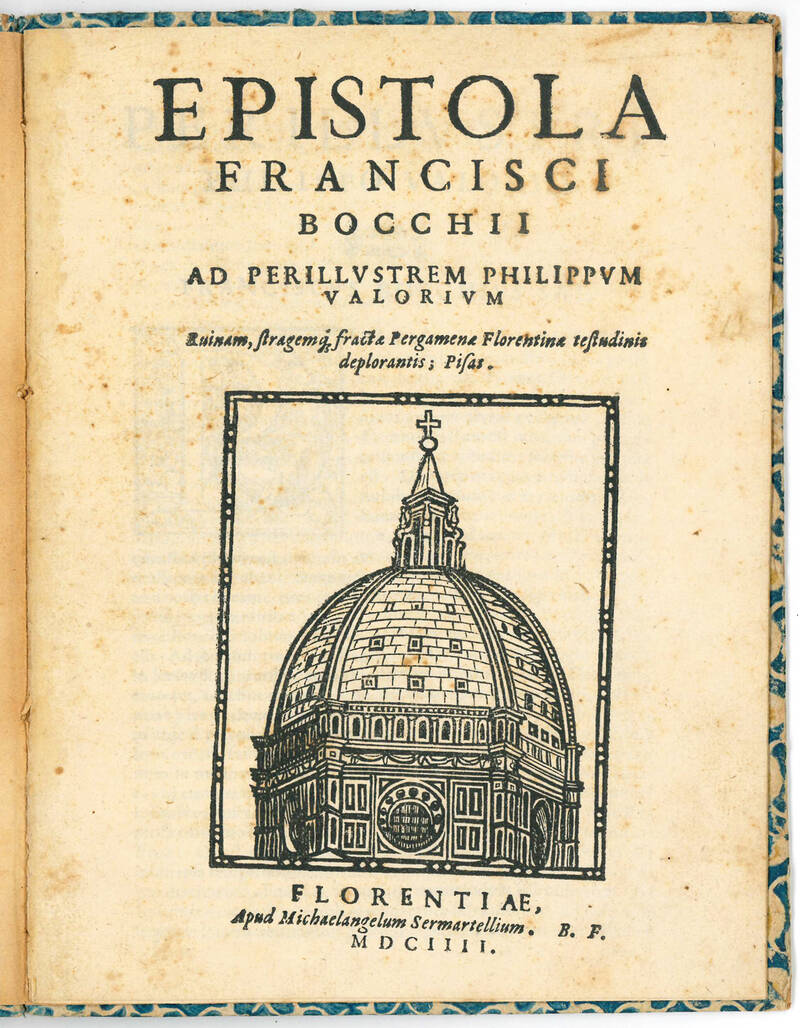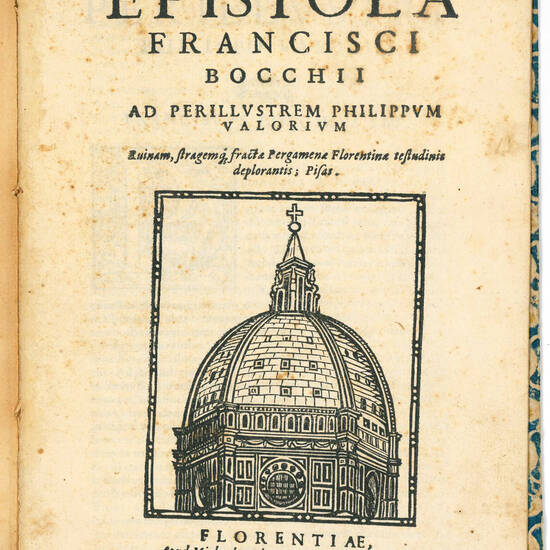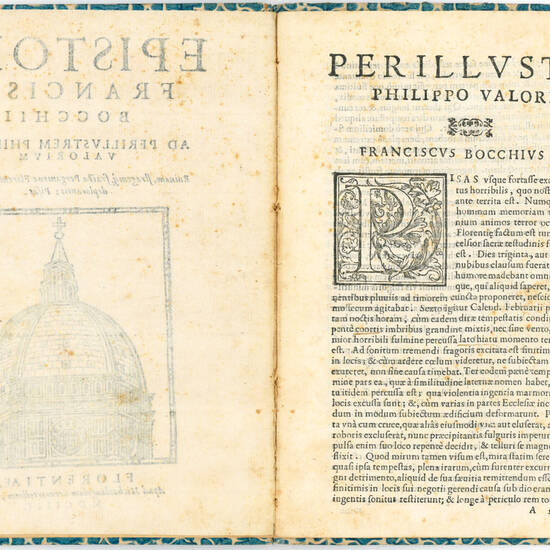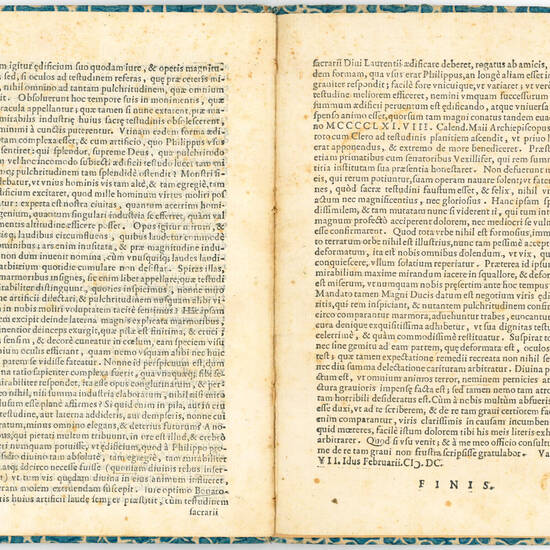THE RESTORATION OF THE BRUNELLESCHI DOME DAMAGED BY A LIGHTNING BOLT
4to (202x152 mm). 7, [1 blank] pp. Collation: A4. Large woodcut vignette on title page showing the Brunelleschi dome of the Florence cathedral. Woodcut decorative initial. With a few contemporary marginal annotations correcting specific terms in the text or clarifying certain passages. Later boards covered with colored paper. Some light foxing, a good copy.
Rare original edition of this letter sent to Filippo Valori, the pope's ambassador in Florence. Although published only in 1604, the letter is dated 7 Februrary 1600, a few days after the dome of the Florence cathedral had been struck by a lightning bolt that during the night of the 27th January damaged the lantern on top of the cupola.
It is the first of two letters written by Bocchi on this subject; the other one, entitled Epistola seu opusculum Francisci Bocchii De restitutione sacræ testudinis Florentinae, addressed to Francesco Nicolini and dated 29 August 1603, was also published by Sermartelli in 1604, with the same woodcut of the cupola on the title page.
In the letter Bocchi is mostly concerned with the restoration of the cupola, which was entrusted to the architect Gherardo Mechini, who designed an ingenious scaffolding and elevation machine system, and completed the work by 1 November 1601 (cf. G. Salvagini, Gherardo Mechini architetto di SuaAltezza: architettura e territorio in Toscana 1580-1620, Florence, 1983, p.106).
Bocchi also celebrates the famous dome, for him one of the pinnacles of Florence artistic magnificence, in front of which “primo laetitia, deinde, cum appropinquant, admiratio, postremo stupor” are the emotions experienced by the viewer. Its creator, Filippo Brunelleschi, is also praised; Bocchi refers that Michelangelo, at the time when he was entrusted with the works of the dome for the Church of San Lorenzo, asked by some friends whether he would imitate or distance himself from the work of Brunelleschi, replied by saying that it would be easier to change but no one had done better than Brunelleschi.
Francesco Bocchi was born in Florence in 1548. Having completed his studies in literature and eloquence, around 1572 he moved for some time to Rome, where he made friends in the Curia circles. Returning to Florence, he led a difficult and precarious existence as a professional man of letters, devoting himself mainly to the education of young noblemen, such as the sons of Benedetto Vivaldi and Piero Antonio Strozzi, and publishing numerous occasional writings, such as encomiastic orations, rhetorical exercises, parenetic letters, and small treatises composed on commission or in the hope of some sort of remuneration. His contemporaries were generous to him with praise and recognition, but not with financial support. The most important of his patrons was Lorenzo Salviati. Bocchi died in Florence in 1618. His printed works include: Discorso a chi de' maggion Guerrieri che insino a questo tempo sono stati, si dee la maggioranza attribuire (Florence, 1573);Oratio de laudibus Ioannae Austriae quae Regina nata Ungariae, et Boemiae, in matrimonio Francisci Medicis, Magni Ducis Etruriae, Florentiae infelici Partu mortem obiit (Florence, 1573; the Italian version, translated by Bocchi himself, appeared at Florence in 1578); Discorso.sopra la lite delle Armi et delle Lettere(Florence, 1579); Discorsosopra la Musica (Florence, 1580); Eccellenza della statua del San Giorgio di Donatello Scultore Fiorentino, posta nella facciata di fuori d'Or San Michele (Florence, 1584); Oratio de laudibus Petri Vectori viri clarissimi (Florence, 1585); Le bellezze della città di Fiorenza dove a pieno di Pittura, di Scultura, di sacri Tempij, di Palazzi i più notabili artifizi e i più preciosi si contengono (Florence, 1591; one of the first guides of the city made by itineraries); Operasopra l'immagine miracolosa della Santissima Nunziata di Fiorenza (Florence, 1592); Oratiode laudibus Philippi II Hispaniarum Regis Catholici et Potentissimi (Florence, 1598); Epistola seu opusculumDe Restitutione Sanctae Testudinis Florentiae ad perillustrem Franciscum Niccolinum, Romam (Florence, 1604); Epistola ad illustriss. et Reverendiss. Cynthium Aldobrandinum S. E. R. cardinalem Ampliss., Romam. De laudibus admodum Reverendi Patris Severini Boldini Veneti, concionatoris Generalis clariss. ex familia Divi Francisci de Observantia(Florence, 1605);Elogia clarissimorum vivorum qui Florentiae claruerunt (Florence, 1607-1609); Orazionesopra le lodi dell'Illustrissimo Signor Lorenzo Salviati Marchese di Giuliano (Florence, 1610). He was also the author of an Historia della ribellione della Fiandra avvenuta sotto la corona del Re Cattolico Filippo Secondo di Spagna (1585) and of an Oratiode laudibus Michaelis Angeli Florentini, Pictoris, Sculptoris atque Architecti nobilissimi, both remained unpublished (cf. S. Menchi, Bocchi, Francesco, in: “Dizionario Biografico degli Italiani”, vol. 11, 1969, s.v.).
D. Moreni, Biblioteca storico-ragionata della Toscana, Florence, 1805, I, pp.135-136; Piantanida, Autori italiani del '600, 4342; Italian Union Catalogue, IT\ICCU\PUVE\027247.
[12708]






